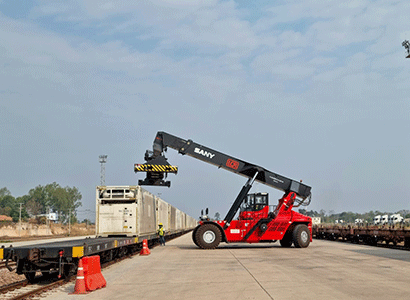Laos: Thanaleng Dry Port cuts transport, shipping costs, developer confirms
The Thanaleng Dry Port offers much cheaper logistics and transport services, its developer has informed local freight forwarder and logistics service providers.
Business executives and representatives of dozens of companies providing transport, logistics and import-export services on Friday visited the dry port in Vientiane to learn about the opportunities offered.
 |
Businesses representatives visit the control room at the Thanaleng Dry Port. |
 |
Mr Chanthone Sitthixay (right) says the Thanaleng Dry Port can provide cheaper transport, logistics costs. |
“We can offer much cheaper [logistics and transport] costs than what you are paying at present,” said Chanthone Sitthixay, Chairman of the Vientiane Logistics Park Co., Ltd. – the developer of the dry port.
He expressed his conviction about reduced costs after learning from businesses about the high prices they normally pay for shipping, transport services and related costs.
A garment exporter in Laos told the meeting that her company spends about 45,000 Thai baht (more than 22 million kip) per truck on average on shipping and related costs to transport garment products to Thailand’s Laem Chabang seaport.
“I can manage to make it just 35,000 baht for all costs, including the service charge at the dry port,” Mr Chanthone said.
“I can recommend shipping and transport companies for you. Altogether, you can save 10,000 baht.”
Meanwhile, a farm product exporter said her company spends between US$1,300-1,400 (about 22-23 million kip) to transport a container from warehouses in Laos to Laem Chabang seaport.
 |
A crane loads containers onto the Laos-Thailand Railway. |
The chairman recommended that the Association of the Lao Garment Industry, other businesses associations and the dry port should work together.
Like garment products, shipping and related costs for other goods will also enjoy cheaper charges compared to those offered by foreign service providers.
“I will make it cheaper. This is a promise,” Mr Chanthone reiterated.
Once cooperation is enhanced, it will create more jobs for local transport providers and their drivers, thus generating more revenue for the government.
The chairman said local freight forwarders and exporters mistakenly believe that use of the dry port carries high costs, citing the lack of communication by both sides.
“Come and talk to me,” the dry port’s Managing Director, Mr Sakhone Philangam, told the guests.
The multimodal-transport dry port, which is located near the first Laos-Thailand Mekong Friendship Bridge, has been open for service since December 2021.
The dry port developer said cross-border transport costs, especially at the friendship bridge, are expected to fall by 40 percent from current prices by 2025.
The developer of Laos’ first-ever integrated logistics centre has pledged to work with the relevant sectors to streamline procedures and speed up services to reduce congestion among trucks entering the dry port.
Talks will be held with the relevant bodies to explore ways to expedite the movement of trucks carrying petrol to quicken distribution, according to Mr Chanthone.
He informed the guests that extensions of the Laos-China and Laos-Thailand railways have been built inside the dry port, to speed up the transport of freight.
Recently, the first rail freight shipment, comprising 286 metric tons of fresh vegetables in cold-chain containers from China’s Yunnan province, arrived in Bangkok, Thailand, after passing through the dry port in Laos.
Given that there is room for the dry port and local shipping and transport business operators to work together, Vice President of the Lao National Chamber of Commerce and Industry, Ms Valy Vetsapong, who led Lao business operators on the visit to the dry port, said that if both sides work collectively and efficiently, it would boost Laos’ negotiating power and competitiveness, bringing the businesses great advantages.
Source: https://www.vientianetimes.org.la/freeContent/FreeConten31_Thanaleng_y23.php


 English
English




